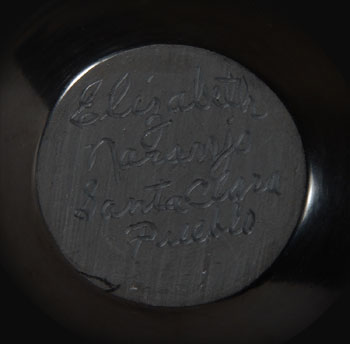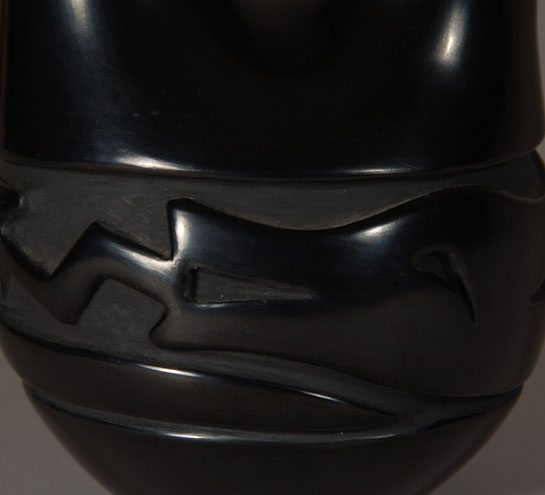Santa Clara Pueblo Wedding Vessel by Elizabeth Naranjo [SOLD]
+ Add to my watchlist Forward to Friend
- Category: Modern
- Origin: Santa Clara Pueblo, Kha'p'oo Owinge
- Medium: native red clay
- Size: 9” tall x 5-1/2” wide
- Item # C3197C SOLD

Teresita Naranjo, of Santa Clara Pueblo, told Betty LeFree, author of Santa Clara Pottery Today, the story of the wedding vessel. We quote from the book:
"After a period of courtship, a boy and girl decide to get married, but they cannot do so until certain customs have been observed. The boy must first call all his relatives together to tell them that he desires to be married to a certain girl. If the relatives agree, two or three of the oldest men are chosen to call on the parents of the girl. Here they pray according to Indian custom and then the oldest man will tell the parents of the girl what their mission is. The parents never give a definite answer at this time—they just say they will let the boy's family know their decision.
"About a week later, the girl calls a meeting of her relatives. The family then decides what answer should be given. If the answer is 'no,' that is the end of it, but if the answer is 'yes,' the oldest men in her family are delegated to go to the boy's home to give their answer and to tell the boy on what day he can come to receive his bride-to-be.
"Now the boy must find a godmother and a godfather. The godmother immediately starts making the wedding vase so that it will be finished by the time the girl is to be received. The godmother also takes some of the stones which are designated as 'holy' and dips them into water to make the designated 'holy water' with which the vase is filled for the day of the reception. The boy also must notify all of his relatives on what day the girl will receive him so that they will be able to buy gifts for the girl.
"The reception day finally comes and the godmother and the godfather lead the procession of the boy's relatives to the home of the girl. The groom-to-be is the last in line and must stand at the door of the girl's home until the gifts have been received and opened by the girl.
"The bride and groom now kneel in the middle of the room with the boy's relatives and the girl's relatives praying all around them. After the prayers, the godmother places the wedding vase in front of the bride and groom.
"The bride then drinks out of one side of the wedding vase and the groom drinks from the other. Then the vase is passed to all in the room—the men drinking from one side and the women from the other.
"After the ritual of drinking the 'holy water' and the prayers, the girl's family feeds all the boy's relatives and a date is set for the church wedding. The wedding vase is now put aside until after the church wedding.
"After the church wedding, the wedding vase is again filled with any drink the family may choose and all the family drinks in the traditional manner—women on one side, men on the other.
"The wedding vase has served its ceremonial function and is now given to the young couple as a good luck piece."
The potter, Elizabeth Naranjo, who made this wedding vessel, is one of a large family of potters, all of whom are exceptional artists. Her sisters, Clara Shije, Reycita Naranjo, Florence Browning, Mary Singer, and Mary Carlisle all are recognized as outstanding potters. One look at this beautifully executed wedding vessel confirms that Elizabeth is among the finest of potters at Santa Clara. She has received many awards at Santa Fe Indian Market, including Best of Division in 1984 for a wedding vessel, 1st Place for a wedding vessel in 1984 and 1st Place again in 1986, 1989 and 1990, all for wedding vessels. That makes a statement for her wedding vessels. This one is no exception.
Condition: The wedding vessel is in original excellent condition
Provenance: ex.coll. Tulsa, OK pottery collectors
Recommended Reading: Santa Clara Pottery Today by Betty LeFree

- Category: Modern
- Origin: Santa Clara Pueblo, Kha'p'oo Owinge
- Medium: native red clay
- Size: 9” tall x 5-1/2” wide
- Item # C3197C SOLD



